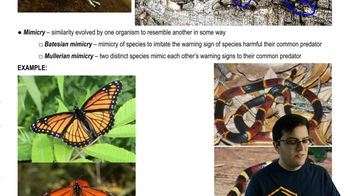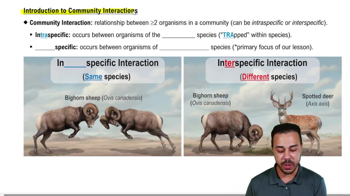Table of contents
- 1. Introduction to Biology2h 42m
- 2. Chemistry3h 40m
- 3. Water1h 26m
- 4. Biomolecules2h 23m
- 5. Cell Components2h 26m
- 6. The Membrane2h 31m
- 7. Energy and Metabolism2h 0m
- 8. Respiration2h 40m
- 9. Photosynthesis2h 49m
- 10. Cell Signaling59m
- 11. Cell Division2h 47m
- 12. Meiosis2h 0m
- 13. Mendelian Genetics4h 44m
- Introduction to Mendel's Experiments7m
- Genotype vs. Phenotype17m
- Punnett Squares13m
- Mendel's Experiments26m
- Mendel's Laws18m
- Monohybrid Crosses19m
- Test Crosses14m
- Dihybrid Crosses20m
- Punnett Square Probability26m
- Incomplete Dominance vs. Codominance20m
- Epistasis7m
- Non-Mendelian Genetics12m
- Pedigrees6m
- Autosomal Inheritance21m
- Sex-Linked Inheritance43m
- X-Inactivation9m
- 14. DNA Synthesis2h 27m
- 15. Gene Expression3h 20m
- 16. Regulation of Expression3h 31m
- Introduction to Regulation of Gene Expression13m
- Prokaryotic Gene Regulation via Operons27m
- The Lac Operon21m
- Glucose's Impact on Lac Operon25m
- The Trp Operon20m
- Review of the Lac Operon & Trp Operon11m
- Introduction to Eukaryotic Gene Regulation9m
- Eukaryotic Chromatin Modifications16m
- Eukaryotic Transcriptional Control22m
- Eukaryotic Post-Transcriptional Regulation28m
- Eukaryotic Post-Translational Regulation13m
- 17. Viruses37m
- 18. Biotechnology2h 58m
- 19. Genomics17m
- 20. Development1h 5m
- 21. Evolution3h 1m
- 22. Evolution of Populations3h 52m
- 23. Speciation1h 37m
- 24. History of Life on Earth2h 6m
- 25. Phylogeny2h 31m
- 26. Prokaryotes4h 59m
- 27. Protists1h 12m
- 28. Plants1h 22m
- 29. Fungi36m
- 30. Overview of Animals34m
- 31. Invertebrates1h 2m
- 32. Vertebrates50m
- 33. Plant Anatomy1h 3m
- 34. Vascular Plant Transport1h 2m
- 35. Soil37m
- 36. Plant Reproduction47m
- 37. Plant Sensation and Response1h 9m
- 38. Animal Form and Function1h 19m
- 39. Digestive System1h 10m
- 40. Circulatory System1h 57m
- 41. Immune System1h 12m
- 42. Osmoregulation and Excretion50m
- 43. Endocrine System1h 4m
- 44. Animal Reproduction1h 2m
- 45. Nervous System1h 55m
- 46. Sensory Systems46m
- 47. Muscle Systems23m
- 48. Ecology3h 11m
- Introduction to Ecology20m
- Biogeography14m
- Earth's Climate Patterns50m
- Introduction to Terrestrial Biomes10m
- Terrestrial Biomes: Near Equator13m
- Terrestrial Biomes: Temperate Regions10m
- Terrestrial Biomes: Northern Regions15m
- Introduction to Aquatic Biomes27m
- Freshwater Aquatic Biomes14m
- Marine Aquatic Biomes13m
- 49. Animal Behavior28m
- 50. Population Ecology3h 41m
- Introduction to Population Ecology28m
- Population Sampling Methods23m
- Life History12m
- Population Demography17m
- Factors Limiting Population Growth14m
- Introduction to Population Growth Models22m
- Linear Population Growth6m
- Exponential Population Growth29m
- Logistic Population Growth32m
- r/K Selection10m
- The Human Population22m
- 51. Community Ecology2h 46m
- Introduction to Community Ecology2m
- Introduction to Community Interactions9m
- Community Interactions: Competition (-/-)38m
- Community Interactions: Exploitation (+/-)23m
- Community Interactions: Mutualism (+/+) & Commensalism (+/0)9m
- Community Structure35m
- Community Dynamics26m
- Geographic Impact on Communities21m
- 52. Ecosystems2h 36m
- 53. Conservation Biology24m
51. Community Ecology
Introduction to Community Interactions
Problem 17f`
Textbook Question
The carnivorous plant Nepenthes bicalcarata ('fanged pitcher plant') has a unique relationship with a species of ant—Camponotus schmitzi ('diving ant'). The diving ants are not digested by the pitcher plants but instead live on the plants and consume nectar. Diving ants also dive into the digestive juices in the pitcher, swim to the bottom, and capture and consume trapped insects, leaving uneaten body parts and ant feces behind.
What nutritional impact do the ants have on fanged pitcher plants?
Do the pitcher plants derive any nutritional benefit from this relationship?
 Verified step by step guidance
Verified step by step guidance1
Understand the mutualistic relationship: The fanged pitcher plant and diving ants have a mutualistic relationship where both parties benefit. The ants consume nectar from the plant and help in capturing and processing trapped insects.
Consider the role of ants in nutrient acquisition: The ants dive into the digestive juices of the pitcher plant, capture trapped insects, and consume them. This process leaves behind uneaten body parts and ant feces, which can contribute to the nutrient pool available to the plant.
Analyze the decomposition process: The uneaten body parts and ant feces left by the ants decompose in the pitcher plant's digestive juices. This decomposition releases nutrients such as nitrogen and phosphorus, which are essential for the plant's growth.
Evaluate the nutritional benefits: The pitcher plant benefits from the nutrients released during the decomposition of insect remains and ant feces. These nutrients are absorbed by the plant, enhancing its ability to thrive in nutrient-poor environments.
Conclude the impact of the relationship: The diving ants play a crucial role in increasing the nutrient availability for the fanged pitcher plant, thereby providing a significant nutritional benefit to the plant through their activities.
 Verified video answer for a similar problem:
Verified video answer for a similar problem:This video solution was recommended by our tutors as helpful for the problem above
Video duration:
2mPlay a video:
Was this helpful?
Key Concepts
Here are the essential concepts you must grasp in order to answer the question correctly.
Mutualism
Mutualism is a type of symbiotic relationship where both parties benefit from the interaction. In the case of Nepenthes bicalcarata and Camponotus schmitzi, the ants provide a cleaning service by removing excess prey, which prevents decay and potential harm to the plant, while the plant offers nectar as a food source for the ants. This mutualistic relationship enhances the survival and growth of both species.
Recommended video:
Guided course

Positive Interactions
Nutrient Recycling
Nutrient recycling refers to the process of breaking down organic matter to release nutrients back into the environment. The diving ants contribute to nutrient recycling by consuming trapped insects and leaving behind uneaten parts and feces, which decompose and release nutrients. These nutrients can be absorbed by the pitcher plant, enhancing its nutrient intake and supporting its growth in nutrient-poor environments.
Recommended video:
Guided course

Soil Nutrients
Carnivorous Plant Adaptations
Carnivorous plants have evolved unique adaptations to capture and digest prey, allowing them to thrive in nutrient-deficient soils. Nepenthes bicalcarata uses its pitcher structure to trap insects, but its relationship with diving ants adds an additional layer of adaptation. The ants help manage the prey load, preventing overflow and decay, while their waste products provide supplementary nutrients, showcasing a complex adaptation strategy for nutrient acquisition.
Recommended video:

Adaptive Radiation

 1:57m
1:57mWatch next
Master Introduction to Community Interactions with a bite sized video explanation from Jason
Start learningRelated Videos
Related Practice


















































